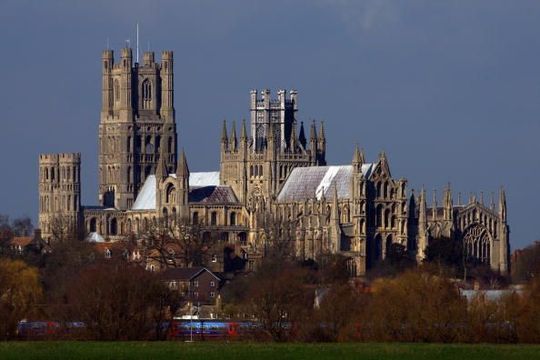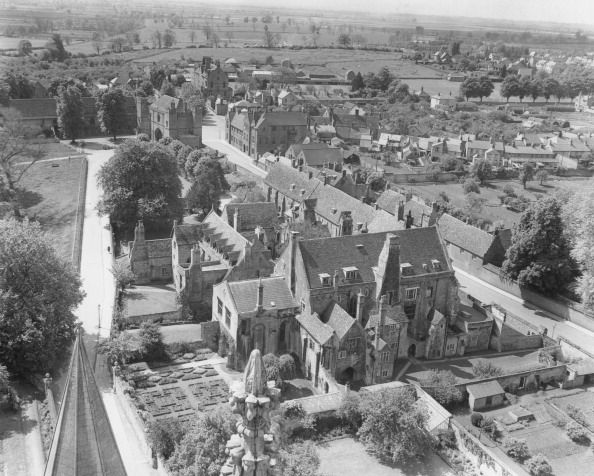
Ely CastleGetty
On a hillock rising above the fens, Eel Island stands proud. Ely is a gorgeous cathedral town. Join us as we take a trip!
With a population of 15,00, Ely is the second-smallest city in England. It is very proud of its connection with eels, hence its name. Even the cross in the cathedral, called The Way of Life, has an eely feel. Local restaurants serve the real thing caught in the River Great Ouse in the form of pate, stew, and pie.
Ely is a beautiful cathedral town in Cambridgeshire, and is undoubtedly one of Britain's most underrated spots to visit! Join us as we take a trip.
Read more
Why go to Ely?
Nestled in the Fen country of East Cambridgeshire, Ely makes a perfect day’s outing—a direct, easy train ride from London. The sight of the magnificent cathedral, either up close or from across the river, sets the tone for a day of historical research, cathedral gazing, river cruising, antiquing or just shopping in the modern precinct or one of the regular markets.
How to get there?
By car, Ely is accessible from the A10 and A14. Trains run regularly from London King’s Cross; the trip takes about an hour.
Where to stay?
Cathedral House is a four-star hotel overlooking the cathedral gardens. It is a Grade II listed historic house.
How to spend the day in Ely?
A visit to the cathedral is a priority. Known as the “Ship of the Fens,” its West Tower soars over the treetops and can be seen for miles. Queen Etheldreda of Northumbria founded a monastery there in 673. Eventually, it was destroyed by the Danes, but Etheldreda is still present, represented in sculptures throughout the church.
In 970 it was revived by Benedictine monks and the present building started. Construction of the church proceeded through the centuries—a Saxon cross here, a Norman arch there, a Romanesque front there—until in 1322, a Norman tower collapsed. It gave Prior Alan de Walsingham an opportunity to build a magnificent 170-foot-high Octagon Tower, constructed of massive oak beams and crowned with a lantern window.
Gazing up into this medieval masterpiece is like viewing a kaleidoscope of stained glass and fan vaulting. It is possible for the strong of leg and lungs to climb both towers. Henry VIII had his wicked way with the cathedral during the Dissolution, but his destruction was limited. Prior Walsingham also constructed the Lady Chapel, the largest of its kind attached to any cathedral. Catch a lunchtime concert in the Cathedral.
The next logical stop is the Stained Glass Museum, the only one of its kind in the country, found within the cathedral. Some of the glowing masterpieces here are ancient and some modern, such as those by stained glass artist Ervin Bossanyi. Little dioramas of painting and firing studios show how this exacting craft was carried on.
The third can’t-miss visit in Ely is Oliver Cromwell’s house, the only one of his residences left standing except for Hampton Court. Cromwell, Lord Protector of England 1653-1658, lived in this half-timbered house from 1636 to 1646 with his wife, Elizabeth, and several of their children. A well-interpreted tour takes visitors to the kitchen, where a dinner to celebrate Cromwell’s election as an MP for Cambridge in 1640 is being prepared. Oysters, neat’s-foot pie, asparagus, spit-roasted meat, and eels are on the menu, while pies bake in the vast fireplace A small bedroom displays clothing, toys, and a crib.

View from Ely Cathedral
Where to have lunch?
The Old Fire Engine House, built in the 18th century, offers a good selection of dishes and drink. Then you can browse or purchase pictures and sculptures in the art gallery.
Where to stop for an afternoon treat?
The Peacocks is listed among Country Living’s 25 favorite tea rooms. Choose a luscious pastry and one of over 60 types of tea and sit on the patio, as wisteria blossoms drop gently into your cup.
Where to shop?
For antique buffs, there’s the three-story Riverside Antiques Centre. More treasures are found in the farmers market on the second and fourth Saturday of each month, the Thursday general market and the Saturday craft and collectibles market. The shopping precinct has an array of craft and gift shops along with traditional stores.
What else to see?
Follow Neil the Eel through the Ely Museum and see a very well-interpreted display. Arrowheads, flint picks and antler hammers testify to the hunters who pursued the wooly mammoths, wolves, beavers, rhino, and hippos in the Iron Age. Pottery bowls demonstrate their artistic abilities. The Anglo-Saxon period is represented by incredible jewelry, swords, and metalwork. “Not all Vikings were vandals. Many Scandinavians settled here,” visitors are told. A boy’s shoes are bricked up in a wall, possibly to ward off witches.
As seems appropriate to a museum housed in the Old Gaol, a rapist is chained to the wall ready to be hanged the next day. Meanwhile, his slightly luckier prison mate contemplates his fate as he is to be transported to Botany Bay. A horse thief tried to escape, so a spiked collar chains him to the floor. In another cell, a debtor’s family is allowed to visit.
The display continues through World War II, with the arrival of the Land Army and the brave Cambridgeshire Regiment’s ordeal in a Japanese prison, to modern times.
Where to have dinner?
The Maltings, a former brewery, provides elegant dining. Don’t miss the tapestry commemorating Ely’s connections with Ribe, Denmark. After dinner, buy a bag of pellets and feed the ducks on the river bank. The Boathouse Restaurant offers local, seasonal produce; bottled ales and wines from local suppliers and river views.
How to spend the evening?
Two different ghostly tours take you around what is said to be one of the most haunted cities in England. Perhaps you’ll see the ghostly dog, Black Shuck, the creeping hand of St. Etheldreda or the ancient Benedictine monks who stroll the cathedral lawn and congregate in Cromwell’s kitchen. One tour finishes in Cromwell’s bedroom also said to be inhabited by a spirit, perhaps the owner’s. Hot chocolate and biscuits take away the chill.
* Originally published in July 2016.





Comments